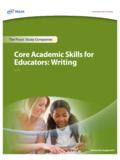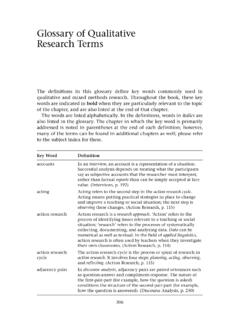Transcription of Multimodal text analysis
1 Multimodal TEXT analysis 1 Multimodal Text analysis Kay L. O Halloran and Bradley A. Smith National University of Singapore Word Count: 2,785 Reference Word Count: 338 Multimodal text analysis has become a crucial part of research, teaching and practice for a wide range of academic and practical disciplines. A variety of techniques, theoretical frameworks and methodologies have therefore evolved for such analysis . For linguists, in particular, concerned with accounting for the communication of meaning within texts , issues arising from the consideration of semiotic resources other than language, in interaction with each other and with language such as gesture, gaze, proximics, dress, visual and aural art, image-text relation and page-layout, cinematographic and sound design and production resources, etc have emerged in recent decades as important challenges.
2 Meanwhile, the emergence of Multimodal studies as a distinct area of study in linguistics has also revealed a range of issues specifically relevant to the Multimodal text analyst. Multimodal TEXT analysis 2 Multimodal analysis includes the analysis of communication in all its forms, but is particularly concerned with texts which contain the interaction and integration of two or more semiotic resources or modes of communication in order to achieve the communicative functions of the text. Such resources include aspects of speech such as intonation and other vocal characteristics, the semiotic action of other bodily resources such as gesture (face, hand and body) and proximics, as well as products of human technology such as carving, painting, writing, architecture, image and sound recording, and in more contemporary times, interactive computing resources (digital media hardwares and softwares).
3 Different semiotic resources bring with them their own affordances and constraints, both individually and in combination, as well as analytical challenges in terms of the natures of the media, the detail and scope of analysis , and the complexities arising from the integration of semiotic resources across media. While it has long been understood that human meaning in the round involves more than simply the (written) language studied by the early linguists (cf Saussure s observations on the need for a semiological science (1916/1974, p. 16) that studies the life of signs within society ), practical and theoretical challenges have meant that it is only in recent decades that a distinct field of Multimodal studies has begun to emerge, and many issues remain unresolved within this field, particularly with respect to text analysis .
4 Halliday (1985) has observed that it wasn t until the wide availability of sound recording technology (in particular tape) that widespread empirical study of authentic natural spoken discourse began, with profound consequences during the 1960s and 1970s for linguistic theory and methodology. Yet studies of speech, as well as other modalities have long remained tied to the analysis of transcriptions rather than a direct ongoing Multimodal TEXT analysis 3 engagement with the source text, bringing issues of transcription to the fore that are relevant to Multimodal text analysis (cf Ochs 1979 for a discussion).
5 The reasons for this constraint are clear: in the first instance, the difficulties of accessing and annotating dynamic audiovisual media such as sound and film are manifest, and modern interactive hypermedia have added further difficulties ( Lemke 2002). Secondly, and as a result, without such access and annotation capabilities a close repeated analytical attention to the source text has been difficult, meaning either that theoretical development has tended to occur without extensive grounding in empirical analysis , or when such grounding is present where Multimodal analysts derive general principles from the close sustained study of Multimodal phenomena within actual text - the texts tend to be static (visual) media or such as can readily be examined and reproduced on the printed page.
6 If the texts analysed are dynamic, the issues both of transcription, Multimodal analysis and reproduction for publication are palpable, particularly in print-based approaches which offer limited resources for Multimodal text analysis ( Baldry and Thibault 2006; O Halloran, in press a; O Halloran et. al. 2010). Two major strategies have thus emerged for dealing with these challenges, constituting two of the major approaches by which Multimodal text analyses can be characterised: one is to explore theory, using text analysis as both test and illustration of the discussion of general principles; and the other is explore actual texts , working from such analyses towards generalizations.
7 The first approach doesn t assume and indeed problematises theory, and much of the work is involved with comparing and integrating knowledge and practice from often disparate theoretical traditions. Multimodal studies suits such an approach, when one considers Multimodal TEXT analysis 4 the wide range of disciplinary and theoretical traditions for which multimodality is relevant. In this approach theoretical generalization is often applied to analyses across several different texts and text types, in order to derive, test and illustrate general principles. The second approach is to pay very close attention to and work from actual specific texts , where the focus is upon the text, building up detailed description, often as a form of running annotation (particularly if the text is dynamic), and usually adapting and applying an established theoretical and descriptive framework but deriving descriptive generalizations out of such text analysis and modifying theory as a result.
8 In this approach, analytical detail is paramount, and again, the challenges of access, transcription, analysis and reproduction in publication are all too apparent. It is interesting to note that two pioneering works in Multimodal text analysis , roughly contemporaneous, can be characterised with respect to these generalizations. The first derives from, among other influences, a synthesis of social semiotics, European semiotics and critical discourse analysis traditions. The exemplar work is Kress and van Leeuwen (1996), where powerful theoretical generalizations from these different schools of thought are applied, calibrated and synthesized via consideration of a diverse range of texts .
9 The Multimodal text analysis appears as both a reference and illustration for the discussion at hand; but it is the theoretical discussion which drives the analysis and text description: generalizations are paramount; while the analysis is usually conducted and presented discursively. Thus, Kress and van Leeuwen (1996) begin a general discussion about the title of the book: highlighting the different between a grammatical and a lexical approach to the semiotics of visual design from the perspective of social semiotic theory, stressing the importance of the distinction between Multimodal TEXT analysis 5 formal and functional theories, and highlighting the relation of specific Multimodal features, structures and systems to more general social (particularly power) structures and (ideological) forces.
10 The dominant visual language is now controlled by the global cultural/technological empires of the mass media, which disseminate the examples set by exemplary designers, and through the spread of image banks and computer imaging technology, exert a normalizing rather than explicitly normative influence on visual communication across the world. Much as it is the primary aim of this book to describe the current state of the grammar of visual design , we will also discuss the broad historical, social and cultural conditions that make and remake the visual language (Kress and van Leeuwen, 1996, pp.)







